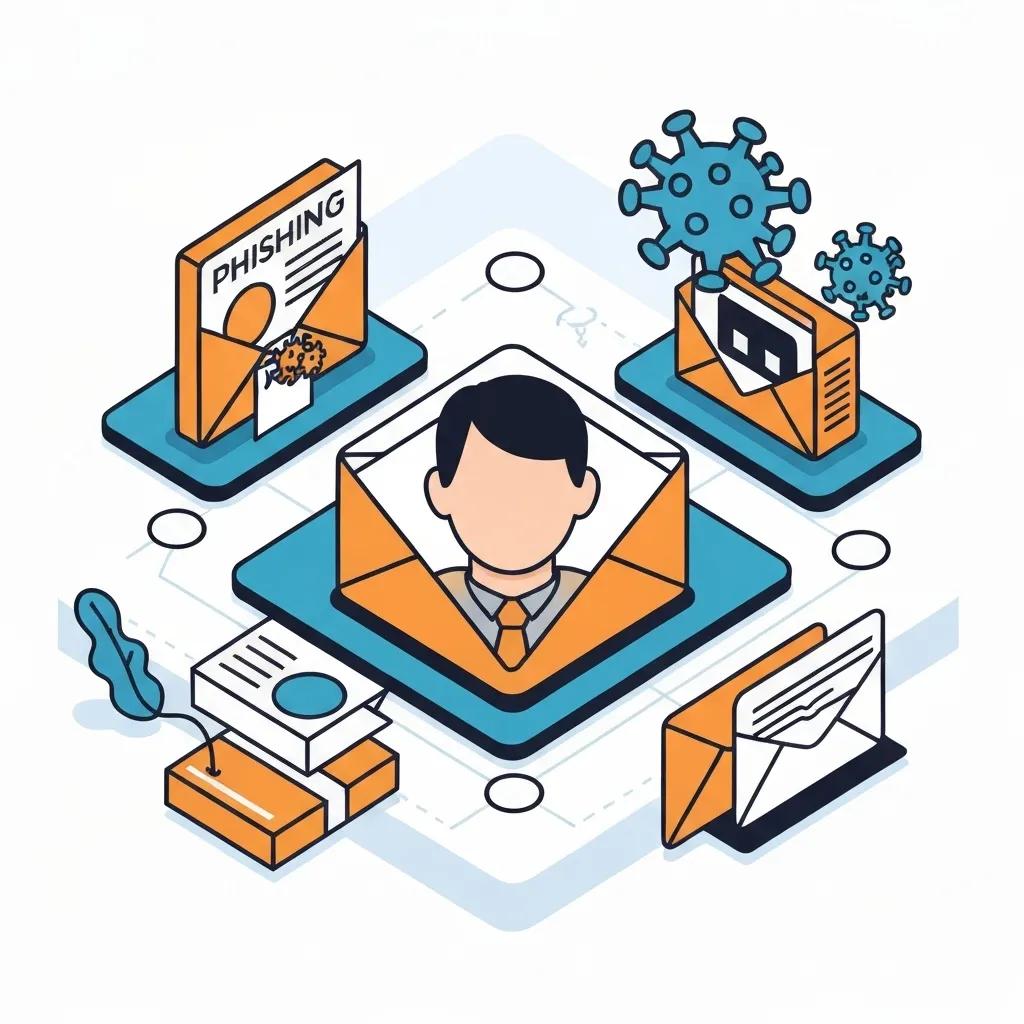Is Your Email Security Leaving You Vulnerable? How Businesses Can Detect, Prevent, and Protect Against Email Cyberattacks
Email security vulnerabilities can expose sensitive data, fuel financial fraud, and disrupt business continuity if left unaddressed. This guide reveals the most common weaknesses—like phishing, business email compromise (BEC), malware, and spoofing—and details how advanced detection, prevention, and protection measures form a multi-layered defense. You will learn to:
- Identify core email threats and weak points
- Implement proactive safeguards such as secure email gateways and multi-factor authentication
- Comply with key regulations and maintain audit trails
- Leverage managed IT services and cybersecurity solutions for local industry challenges
- Respond swiftly to breaches and prepare for emerging trends
Read on to enhance your email security posture and safeguard your business communications.
What Are the Most Common Email Security Vulnerabilities for Businesses?
Email security vulnerabilities are weaknesses that attackers exploit to infiltrate networks, steal credentials, or deliver malware. These gaps often stem from inadequate authentication, lack of encryption, outdated filtering tools, or human error. For example, unencrypted messages expose sensitive data in transit, while employees unaware of social engineering tactics may unwittingly grant access to threat actors. Understanding these vulnerabilities establishes the foundation for deploying stronger controls across your organization.
Email Security Vulnerabilities
Email is a primary target for cybercriminals who exploit vulnerabilities to compromise sensitive information. Common threats include phishing, business email compromise, and malware attacks, each posing significant risks to organizations.
Which Email Threats Put Your Business at Risk?

Email channels face multiple threat categories that collectively account for over 90% of cyberattacks.
- Phishing: Deceptive emails designed to harvest credentials or install malware
- Business Email Compromise (BEC): Targeted fraud exploiting executive impersonation
- Malware and Ransomware: Malicious attachments or links that encrypt or steal data
- Email Spoofing: Impersonation of legitimate domains to deceive recipients
These threats exploit both technology gaps and human factors, making a layered approach essential to prevent breaches and financial losses.
How Does Phishing Exploit Email Vulnerabilities?
Phishing exploits weaknesses in email authentication by tricking recipients into revealing credentials or clicking malicious links. Attackers craft messages that mimic trusted senders—such as banks or vendors—then embed links to credential-stealing sites or weaponized attachments. Successful phishing undermines login security, often leading to account takeover or malware deployment, and highlights the importance of both technical filters and employee vigilance for early detection.
What Is Business Email Compromise (BEC) and How Does It Impact Companies?
Business Email Compromise (BEC) involves sophisticated social engineering where attackers impersonate executives, vendors, or partners to authorize fraudulent wire transfers or data requests. This threat leverages compromised or spoofed email accounts to exploit trust and urgency, often resulting in significant financial loss. In 2023, BEC attacks cost organizations an average of $2.9 billion per incident, underscoring the need for identity-validation controls and transaction-approval workflows.
Business Email Compromise Statistics
In 2023, the IC3 received 21,489 BEC complaints with adjusted losses over $2.9 billion. BEC is a sophisticated scam targeting both businesses and individuals performing transfers of funds.
How Do Malware and Ransomware Spread Through Email?
Email remains the primary vector for deploying malware and ransomware by attaching infected documents or embedding malicious URLs. When recipients open a booby-trapped attachment or click a concealed link, the payload executes code that can exfiltrate data or encrypt files for ransom. Advanced threat protection tools—such as sandboxing and URL threat defense—help isolate suspicious payloads and block delivery before it reaches the inbox.
Why Is Email Spoofing a Critical Security Concern?
Email spoofing manipulates header information to make messages appear from legitimate domains, eroding trust in sender identities. Spoofed emails bypass simple sender-filter rules, deliver phishing lures, or leak brand reputation when customers or partners receive fraudulent communications. Implementing domain-based authentication protocols like SPF, DKIM, and DMARC ensures message integrity, reducing spoofing success rates and strengthening overall email authenticity.
How Can Businesses Detect and Prevent Phishing and Other Email Attacks?
Detecting and preventing email attacks requires a combination of automated filtering, behavior-based analysis, and user-centric defenses. By layering these techniques, organizations can identify malicious patterns early and block threats before they reach employees’ inboxes.
What Are Effective Phishing Attack Detection Techniques?
Effective phishing detection combines AI-driven analysis with signature-based scanning and anomaly-detection algorithms. Key techniques include:
- Machine Learning Filters that analyze email content, headers, and sender behavior for phishing indicators.
- Link Reputation Services that block URLs associated with known fraud or malware distribution.
- Attachment Sandboxing that executes suspicious files in isolated environments to reveal hidden threats.
Phishing Detection Techniques
Effective phishing detection combines AI-driven analysis with signature-based scanning and anomaly-detection algorithms. Key techniques include machine learning filters, link reputation services, and attachment sandboxing.
How Does Multi-Factor Authentication (MFA) Strengthen Email Security?
Multi-Factor Authentication (MFA) strengthens email security by requiring two or more verification factors—such as a password plus a one-time code or biometric scan—before granting access. This mechanism mitigates credential theft since stolen passwords alone cannot complete authentication. MFA blocks over 99.9% of account takeover attempts while remaining user-friendly when integrated through authenticator apps, SMS codes, or hardware tokens.
What Role Do Secure Email Gateways (SEGs) Play in Blocking Threats?
Secure Email Gateways (SEGs) act as the first line of defense, filtering inbound and outbound mail through content inspections, threat intelligence feeds, and policy enforcement. SEGs enforce encryption, block malicious attachments, quarantine suspicious messages, and log delivery events for audit trails. This centralized control prevents known and unknown threats from reaching users while supporting compliance requirements.
How Can Sandboxing and URL Threat Defense Prevent Email Malware?
Sandboxing executes attachments in controlled environments to detect stealthy malware behaviors—such as unauthorized system changes—before delivery. URL threat defense rewrites or inspects links at click time, blocking access to newly registered or compromised domains. Together, these advanced threat protection features ensure that even zero-day exploits and fast-morphing URLs cannot bypass perimeter defenses.
Why Is Employee Security Awareness Training Essential for Prevention?

Employee security awareness training transforms the workforce into a human firewall by teaching staff to recognize phishing cues, validate unexpected requests, and report suspicious messages. Effective programs include simulated phishing exercises, ongoing micro-learning modules, and role-based scenarios tailored to executive staff, finance teams, and IT personnel. Cultivating security-minded behavior reduces click-through rates on phishing tests by over 70% and strengthens overall organizational resilience.
What Are the Key Email Security Solutions to Protect Sensitive Business Data?
Protecting sensitive communications demands a comprehensive suite of solutions that encrypt data, prevent loss, enforce authentication, and leverage managed expertise. Together, these pillars safeguard information integrity, confidentiality, and availability.
How Does Email Encryption Safeguard Business Communications?
Email encryption safeguards business communications by encoding messages so that only authorized recipients can decode and read content. Whether using Transport Layer Security (TLS) for in-transit encryption or end-to-end methods like S/MIME and PGP, encryption prevents eavesdropping, data leakage, and unauthorized access.
| Protocol | Encryption Scope | Benefit |
|---|---|---|
| TLS | In-transit between servers | Ensures data privacy during delivery |
| S/MIME | End-to-end per recipient | Enables digital signing and confidentiality |
| PGP | User-managed keys | Grants flexibility for external partners |
These protocols ensure that sensitive data—such as financial records or patient health information—remains confidential across untrusted networks, meeting both security and compliance needs.
Email Encryption for Compliance
Regulations such as GDPR, HIPAA, and PCI DSS mandate specific controls to protect regulated data. Email encryption supports compliance by converting sensitive content into unreadable ciphertext, meeting legal requirements for data protection.
What Is Data Loss Prevention (DLP) and How Does It Protect Email Data?
Data Loss Prevention (DLP) tools monitor email content for sensitive data patterns—like credit card numbers, Social Security numbers, or proprietary documents—and enforce policies to block, encrypt, or quarantine messages containing that data. By scanning headers, body text, and attachments in real time, DLP prevents accidental or malicious leaks, supports audit logging, and ensures that regulated information never leaves authorized boundaries.
How Do Strong Passwords and Authentication Practices Reduce Vulnerabilities?
Strong passwords and strict authentication practices reduce vulnerabilities by making it harder for attackers to brute-force or guess credentials. Best practices include:
- Using passphrases of at least 12 characters with varied character types
- Implementing password vaults for secure storage
- Rotating credentials on a defined schedule
- Enforcing MFA for all access points
These measures enhance account security and form a critical layer beneath advanced controls like secure email gateways and encryption.
What Are the Benefits of Managed Email Security Services for Businesses?
Managed email security services offer 24/7 monitoring, rapid incident response, and expert configuration of advanced defenses without burdening internal IT teams. Providers deliver proactive threat intelligence updates, compliance reporting, and tailored training programs—all backed by service level agreements. This approach ensures continuous protection, reduces operational costs, and leverages specialized expertise that many businesses cannot replicate in-house.
Benefits of Managed Email Security Services
Managed email security services offer 24/7 monitoring, rapid incident response, and expert configuration of advanced defenses without burdening internal IT teams. This approach ensures continuous protection, reduces operational costs, and leverages specialized expertise.
How Do Email Security Compliance Requirements Affect Business Practices?
Email security compliance requirements mandate specific controls, documentation, and reporting to protect regulated data and avoid penalties. Adhering to these standards influences technology choices, policy development, and audit readiness across industries.
What Are the Main Email Security Regulations Businesses Must Follow?
| Regulation | Requirement | Impact |
|---|---|---|
| GDPR | Consent, pseudonymization, encryption | Protects personal data of EU residents |
| HIPAA | PHI encryption, access controls | Ensures confidentiality of health data |
| PCI DSS | Encryption of cardholder data | Safeguards payment processing |
| SOX | Retention of financial records | Maintains transparency in reporting |
Compliance drives the adoption of encryption, audit trails, and DLP, embedding security into daily email operations and risk management processes.
How Does Email Encryption Support Regulatory Compliance?
Email encryption supports compliance by converting sensitive content into unreadable ciphertext, thereby meeting legal requirements for data protection in transit and at rest. Regulations such as GDPR and HIPAA explicitly call for encryption to safeguard personal and health information, while PCI DSS mandates strong cryptography for payment data. This alignment reduces the risk of costly fines and reputational damage.
What Are Best Practices for Maintaining Email Security Audit Trails?
Maintaining audit trails involves capturing detailed logs of email events—such as senders, recipients, timestamps, delivery statuses, and encryption actions—and storing them securely for review. Best practices include:
- Centralized logging with tamper-evident storage
- Automated reports highlighting policy violations
- Retention schedules aligned with regulatory timelines
- Regular audits to validate log integrity
Robust audit trails enable accountability, support incident investigations, and demonstrate compliance during regulatory assessments.
How Can Businesses Navigate Industry-Specific Email Security Challenges?
Different sectors face unique email security hurdles—such as PHI protection in healthcare, intellectual property safeguarding in energy, and financial transaction integrity in banking. Tailored strategies include specialized DLP policies, role-based access controls, and sector-focused training scenarios. By partnering with experts in managed IT services and cybersecurity, organizations in each industry can deploy customized solutions that address their particular threat landscape and compliance demands.
Why Do Businesses Need Specialized Email Security Solutions?
Businesses’ leading industries—energy, infrastructure, healthcare, and finance—operate under heightened regulatory scrutiny and face sophisticated threat actors targeting critical systems. Local providers offer on-site expertise, rapid response capabilities, and deep understanding of regional compliance frameworks to bolster email defenses effectively.
What Unique Email Security Threats Do Energy and Infrastructure Companies Face?
Energy and infrastructure firms contend with targeted attacks aiming to disrupt operations, steal proprietary data, or manipulate industrial control emails. Threat actors often launch spear-phishing campaigns that mimic utility vendor notifications or maintenance schedules, seeking credentials that unlock operational networks. Specialized segmentation, encrypted communication channels, and continuous monitoring help mitigate these high-stakes risks.
How Can Managed IT Services Enhance Email Security?
Managed IT services deliver a cohesive security stack—combining secure email gateways, DLP, encryption, and threat intelligence—with local support and 24/7 monitoring. These services integrate seamlessly with existing Microsoft 365 or Google Workspace environments, ensure swift policy updates, and provide on-demand incident response. Local expertise guarantees rapid deployment and tailored configurations suited to businesses’ industry regulations.
What Are the Advantages of Partnering with a Cybersecurity Provider?
Partnering with a cybersecurity provider fosters trust, reduces response times, and aligns security initiatives with regional compliance requirements. Local teams understand the specific risks faced by businesses in energy, finance, and healthcare, enabling proactive threat hunting and cultural alignment. This collaboration accelerates remediation, improves visibility across on-premises and cloud environments, and reinforces stakeholder confidence in email security.
How Can Businesses Respond Effectively to Email Security Breaches?
When a breach occurs, a structured incident response plan ensures swift containment, analysis, and recovery. Rapid detection and coordinated action minimize disruption and financial impact.
What Are the Steps in an Email Security Incident Response Plan?
- Preparation: Define roles, communication channels, and recovery procedures.
- Identification: Detect anomalies via monitoring tools and user reports.
- Containment: Isolate affected accounts and revoke compromised credentials.
- Eradication: Remove malicious code, update filters, and strengthen controls.
- Recovery: Restore services, validate integrity, and resume normal operations.
- Lessons Learned: Conduct a post-mortem to refine policies and training.
This structured process enhances resilience and informs continuous improvement.
How Can Rapid Threat Detection Minimize Business Impact?
Rapid threat detection leverages real-time alerts from AI-powered analytics and 24/7 monitoring to identify suspicious email events—such as unusual login locations or mass-mailing patterns—within minutes. Early warnings allow security teams to block malicious traffic, isolate infected systems, and prevent lateral movement, significantly reducing potential data loss and operational downtime.
What Role Does Employee Training Play in Post-Breach Recovery?
Employee training plays a pivotal role in post-breach recovery by ensuring staff can recognize phishing attempts, follow updated security protocols, and report anomalies quickly. Conducting targeted refresher courses on incident response procedures instills confidence and clarity about individual responsibilities, accelerating containment and reducing the likelihood of repeat incidents.
What Are the Emerging Trends and Technologies in Email Security?
Email security continues to evolve as attackers employ advanced tactics and defenders innovate with new technologies. Staying ahead of these trends is vital for sustained protection.
How Is AI/ML Revolutionizing Email Threat Detection?
AI and machine learning revolutionize email threat detection by continuously analyzing vast datasets to identify subtle attack patterns, zero-day malware behaviors, and evolving social engineering techniques. These algorithms adapt in real time, improving accuracy in spotting polymorphic threats and reducing false positives while enabling predictive risk scoring for incoming messages.
What Are the Challenges of MFA Bypass and How to Mitigate Them?
Despite blocking over 99.9% of account takeovers, MFA can be bypassed through phishing-based relay attacks or SIM-swap fraud. Mitigation strategies include using phishing-resistant authenticators (such as FIDO2 security keys), enforcing adaptive authentication based on risk scoring, and monitoring MFA approval requests for anomalous activity.
How Are Deepfake Emails and Social Engineering Evolving?
Deepfake emails leverage AI-generated voice snippets, realistic avatar videos, and context-aware language to impersonate stakeholders convincingly. Combined with social engineering, these attacks exploit trust and urgency at unprecedented sophistication levels. Defense requires advanced identity verification, voice-analysis tools for call-in confirmations, and continual awareness training highlighting emerging tactics.
What Future Email Security Measures Should Businesses Prepare For?
Businesses should prepare for quantum-safe encryption to guard against future decryption capabilities, AI-driven autonomous response agents that neutralize threats proactively, and integrated security meshes that unify email, endpoint, and network defenses. Embracing these innovations now will ensure organizations remain resilient as threat landscapes continue to advance.
Email security demands a strategic, multi-layered approach—from identifying vulnerabilities and deploying advanced detection tools to enforcing robust encryption, compliance controls, and employee training. With emerging AI/ML enhancements and specialized managed IT services, businesses can build a resilient defense that adapts to evolving threats. Proactive planning and local expertise transform email from a security risk into a trusted communication channel. Contact our team today for a comprehensive email security assessment and take the first step toward safeguarding your organization’s critical communications.



